Mouldy specks on clothes are an eyesore! The green, black and white spots tarnish a once-loved outfit. And they can also pose health risks and be expensive to put right!
So, should you bin the mould-ridden clothes or keep them?
Before you decide to throw out or keep your mouldy clothes, you have to consider the health risks and costs involved, as well as the environmental impact binning or keeping the garments will have.
Cleaning may be a viable option for minor mouldy issues on sturdy fabrics. However, in cases where there is severe contamination, especially on delicate materials or valuable garments, discarding them could be the safest option.
Let’s look at the main factors that need to be considered.
Factors to Consider Before Binning Mouldy Clothes
1. The severity of the mould

As noted above, if you’ve only got a few dots of mould on your outfit, you can usually treat and keep it.
On the flipside, a whole infestation, where all your clothes are covered in mould, will be more difficult to treat, and you might not be able to save all the garments.
Similarly, the age of the mould will determine if a garment can be saved or thrown out. The longer the mould has to thrive and embed itself in an item of clothing, the more difficult it is to remove.
Naturally, if your garment becomes overrun with mould, the materials will deteriorate, and the mould will spread around.
Ultimately, you won’t be able to wear your garment because it’ll be a health risk. Plus, the item won’t look very good.
2. The material
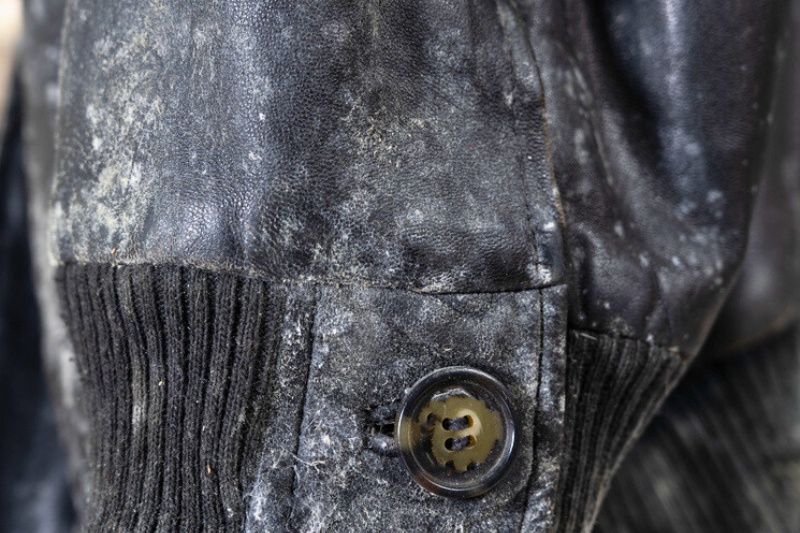
Delicate fabrics don’t hold up as well when treated with strong mould cleaners. This makes it difficult to treat and eradicate a mould infestation.
Likewise, older or vintage pieces need to be handled with care, or they could end up ruined.
Hard-wearing materials, like cotton, can hold up for longer when being treated.
3. The scale of the work involved

You’ve got to be realistic when it comes to mould. If you’ve got a single mouldy item, the chances are you can either treat or bin it.
In contrast, if you’ve not managed the mould problem and it’s been allowed to run rampant, the likelihood is that most of your garments will be tainted (some more than others, of course).
If the job is huge, consider how much time, money and effort you’ll have to put into rectifying the situation.
You also have a more significant health risk to manage. So, it might be better to dispose of the clothes.
4. Costs involved
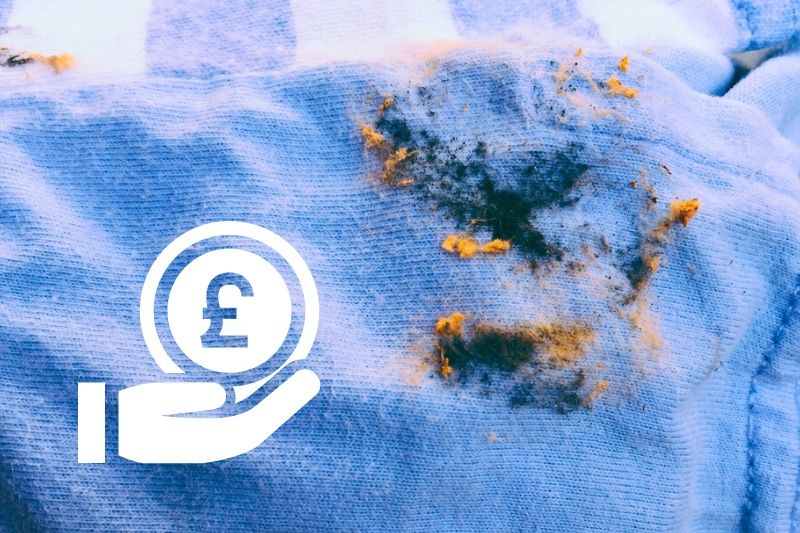
Weigh up the factors above and think about how much it will cost you to treat your clothes. OR think about if it would be possible to buy new ones to replace the damaged ones.
Depending on the extent of your mould issue, you might have to invest in different cleaning solutions or several of them. In the end, you might spend a lot of money trying to save your clothes.
Of course, if it’s not possible to replace damaged clothes, treating them is the best way forward. Just keep in mind that this won’t be as cheap as you might hope it to be.
The main concerns with mouldy clothes are that they pose a health risk and there’s potential for the mould to spread around quickly.
It’s crucial to assess the mould’s severity before treating it. If it’s widespread or on a delicate fabric, the risks often outweigh the benefits of trying to clean the mould away.
Remember, you should act fast and address the mould problem so it doesn’t have time to spread and worsen. This way, you won’t find yourself in this mouldy conundrum.
The Case for Throwing Out Mouldy Clothes
Here are some arguments for binning your mouldy garments:
Health risks
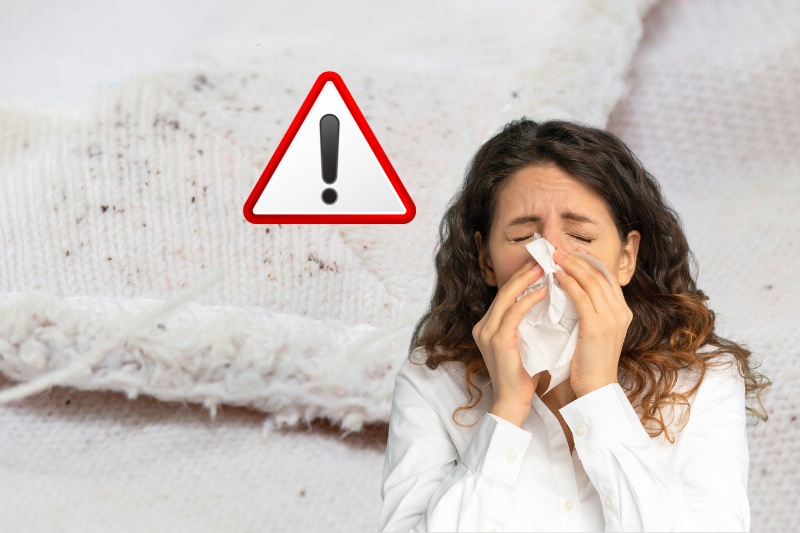
Mould spores can trigger allergic reactions, respiratory problems and other health issues. For individuals with pre-existing health conditions like asthma or immune disorders, the risks are even higher.
If there’s any risk, throwing the clothes out is the best option. In fact, it would be dangerous to treat the garments because you’d have to come into contact with the mould for a long time.
Spread of mould
Mould can easily spread from one garment to another, especially in confined spaces like wardrobes and drawers. This cross-contamination can lead to larger mould problems in your home.
For example, a mouldy cotton dress sitting idle in the wardrobe could contaminate your delicate silk scarves. Although you might be able to treat and rescue your cotton dress (hard-wearing material), the same cannot be said for your delicate garments.
Similarly, if you don’t treat one mouldy item, you’ll soon become overrun with a mould infestation in your drawers/wardrobe.
Consequently, you’ll have to bin your mould-ridden garments because treating all the damaged items wouldn’t be cost-effective or appropriate.

Damage to materials
Some moulds produce enzymes that break down fabrics, leading to permanent damage.
Delicate and vintage clothes may be particularly vulnerable to this. Consequently, some garments will be beyond repair and will need to be thrown out.
The Case for Keeping Mouldy Clothes
Here are some arguments against binning your mouldy garments:
Environmental concerns
Throwing away clothes contributes to waste and impacts the environment. Over the years, many organisations have been vocal about reducing waste and have stressed the importance of repairing and reusing items wherever possible.
If your outfits aren’t badly damaged, you can treat the mould and keep the item.
Cleaning solutions
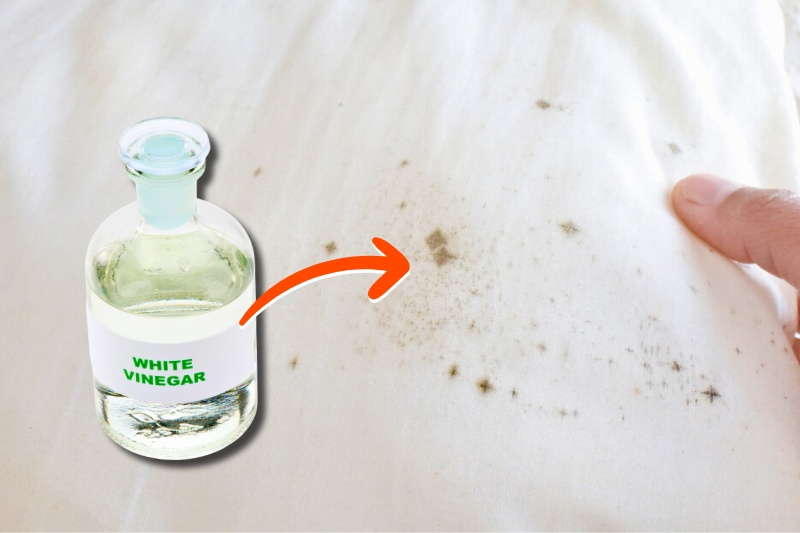
Mild cases of mould can often be treated with homemade remedies. A simple solution of white vinegar and bicarbonate of soda can remove mould from items of clothing.
This is a relatively cheap way of solving the problem, thus saving you on waste and having to purchase new clothes.
However, the age and extent of the mould will impact how well this solution works.
Cost considerations
Replacing clothes can be expensive and isn’t always possible. When this is the case, cleaning mouldy clothes is the most cost-effective way of managing the situation.
How to Remove Mould from Clothes
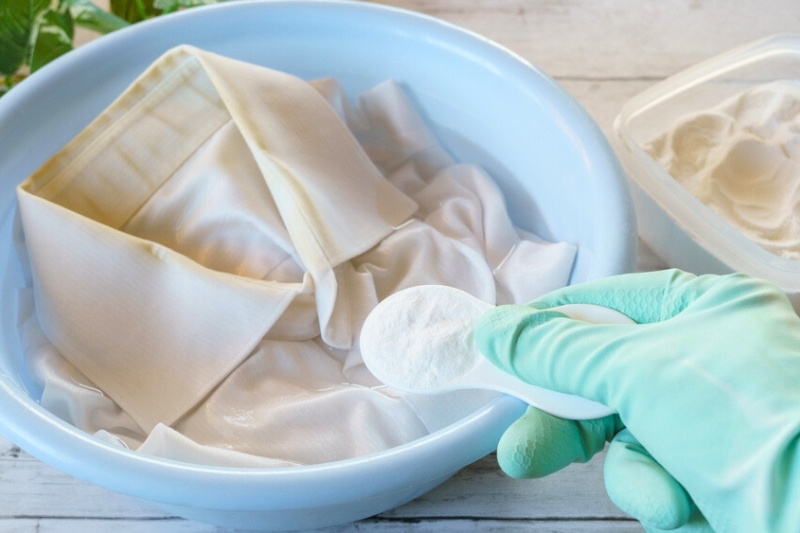
Before you carry out the methods below, you must perform a patch test. The solutions mentioned could discolour or damage colourful and delicate clothes.
Steps to follow:
- Put protective gear on (eyewear, mask and gloves).
- Take the mouldy clothes outside and brush them down. Use one of the methods below:
- Soak each item in a tub of white vinegar (one cup) and water for one hour. Then move on to Step 3
- Mix one part oxygen-safe bleach with three parts water and squirt your mouldy items with the solution. Wait a few minutes, then move on to Step 3.
- Spray hydrogen peroxide (3% version) directly onto the mould stains. Wait 10 minutes, then move on to Step 3.
- Wash your item in the washing machine at the highest temperature possible for the material. Remember to add a normal dose of detergent.
- Add a sanitiser if you like.
- Run an additional hot cycle without detergent.
- Check your garment after the wash and treat it again, if need be.
- Dry the item in direct sunlight so the sun can work on the remaining mould (spores) for you. The breeze and fresh air will also remove lingering odours.
If you need to hand wash your clothes, pre-treat them using the steps mentioned above, then soak the clothes in a tub of hot water (hottest temperature permitted for the material), add detergent and gently agitate the clothes.
Then, leave the laundry to rest in the water for 20 minutes. After 20 minutes, rinse the clothes off and allow them to dry naturally.
Ideally, you need to react quickly to the mould and eradicate it before it worsens and spreads. If you catch the issue early on, you can remove it and save your garments.
The longer you leave the problem, the worse it gets. This is when your pieces of clothing are mostly to end up covered and ruined by mould. Naturally, they’ll need to be thrown out because they’ll be a risk to you.
How to Stop Clothes Going Mouldy

Treating mouldy clothes or throwing them out on a regular basis isn’t great. If you find yourself in this situation too often, think about why your clothes are getting mouldy and put measures in place to stop your outfits from getting mould-ridden.
Consider the following:
- Don’t leave wet or damp clothes hanging around. Dry and store them correctly.
- Don’t put wet clothes in the laundry basket. The items will end up sitting there for days, and they’ll eventually be covered in specks of mould.
- Clean your washing machine. The appliance is known for getting mouldy, so make sure this mould doesn’t spread onto your clothes by maintaining the machine.
- Ensure there’s good ventilation in your home, especially in your wardrobes.
- Use dehumidifiers and extractor fans to remove excess moisture.
- Declutter your wardrobes often.
- Don’t store damp clothes in your wardrobes and drawers.
- Don’t pack your clothes tight inside a wardrobe or drawer.
- Open your wardrobe doors/drawers during the day to allow fresh air to circulate.
- Allow plenty of natural light into your room.
- Put vents on your wardrobe to ensure good ventilation.
- Treat existing mould problems effectively to stop the spread of the problem. Finding the root of the problem and stopping it at the source is better than constantly dealing with the symptoms of the issue.
- Remove as much condensation from the area as possible.
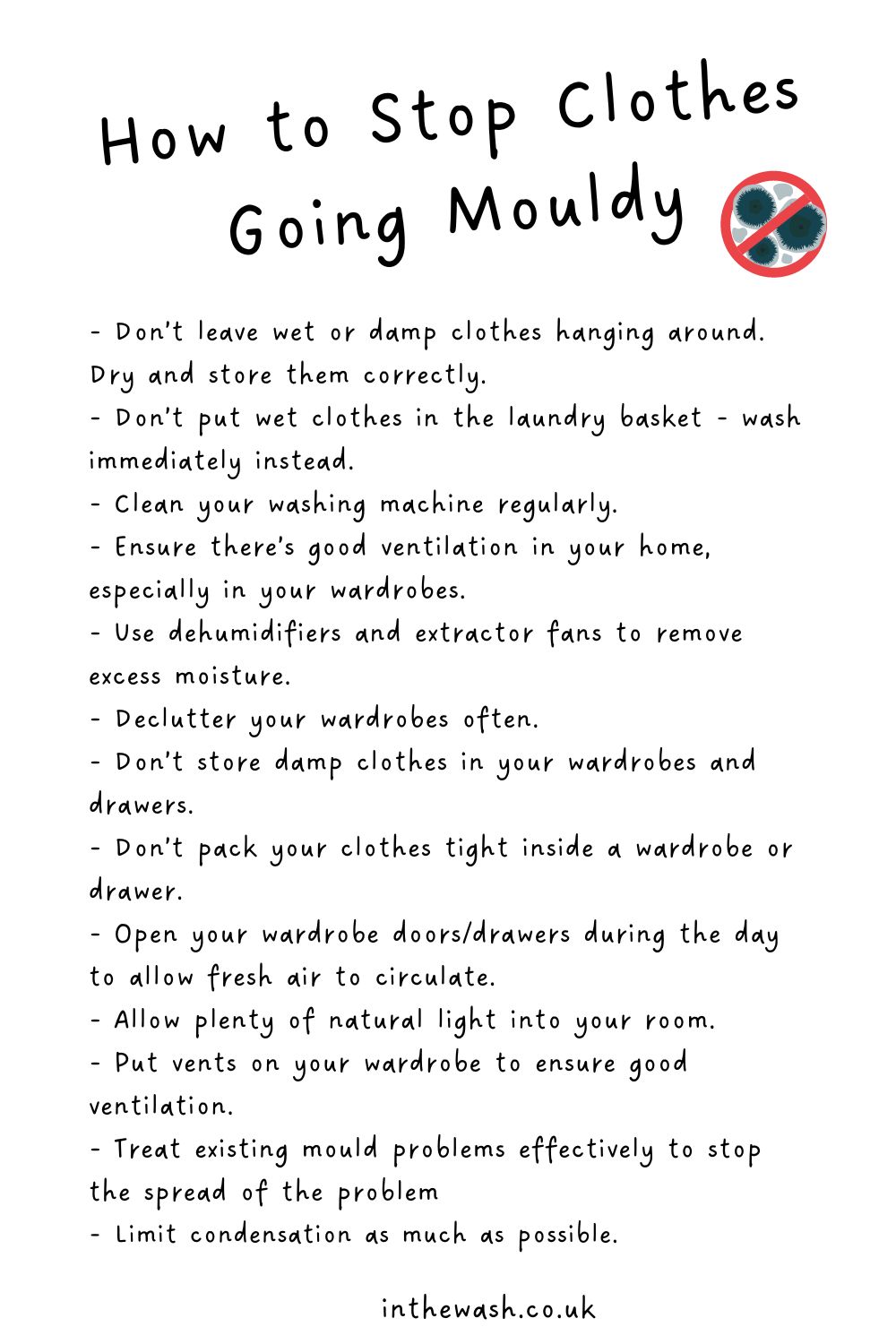
FAQs on Mouldy Clothes
Is it okay to wear mouldy clothes?
It’s not advisable to wear clothes covered in mould because the mould can trigger respiratory issues, rashes and allergic reactions.
You should try to clean the mould off your garments, launder and dry them, and then wear them (assuming that the mould has been treated and eradicated).
If the damage to your items is too severe, consider throwing them away.

Does washing clothes remove mould?
A lot of mould will be removed during the washing process. This is particularly true if you’ve only got a little bit of mould on your outfits and you’ve reacted quickly to the problem.
However, if your clothes are covered in a lot of mould and its quite old, washing alone may not be enough to eradicate the spores. You will likely need to pre-treat your garments and then wash them.
Treat your outfits to kill the mould whenever possible, then clean them as usual. Doing this ensures that the garments are treated effectively and that the mould knows it has no place on your items.
In addition, you must be careful when you launder mould-ridden clothes with non-mouldy clothes because you could contaminate the clean clothes during the washing process.
By the end of a cleaning cycle, you might end up with more mouldy items than you started off with. Yet another reason to treat your garments before you wash them.
Can all types of fabric be treated for mould?
Hard-wearing fabrics, like cotton, can be treated. However, treating delicate materials like wool and silk is often trickier because they might end up damaged by a mould-cleaning solution.
If you need to treat a mouldy, delicate item, always pick a natural cleaning solution and do a patch test first.
Is it safe to clean mouldy clothes at home?
For items that are tainted by minor mould-related issues, yes, you can clean them at home.
For bigger problems or if you have health concerns, you should ask a professional for advice.

Bethan has a passion for exploring, reading, cooking and gardening! When she’s not creating culinary delights for her family, she’s concocting potions to keep her house clean!






